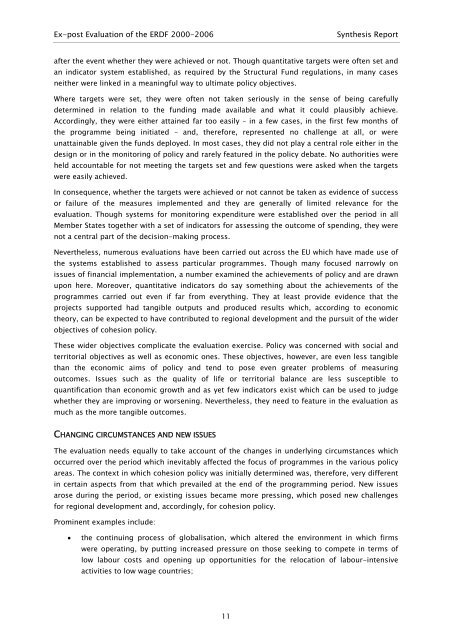Synthesis Report - European Commission - Europa
Synthesis Report - European Commission - Europa
Synthesis Report - European Commission - Europa
You also want an ePaper? Increase the reach of your titles
YUMPU automatically turns print PDFs into web optimized ePapers that Google loves.
Ex-post Evaluation of the ERDF 2000-2006<br />
<strong>Synthesis</strong> <strong>Report</strong><br />
after the event whether they were achieved or not. Though quantitative targets were often set and<br />
an indicator system established, as required by the Structural Fund regulations, in many cases<br />
neither were linked in a meaningful way to ultimate policy objectives.<br />
Where targets were set, they were often not taken seriously in the sense of being carefully<br />
determined in relation to the funding made available and what it could plausibly achieve.<br />
Accordingly, they were either attained far too easily – in a few cases, in the first few months of<br />
the programme being initiated – and, therefore, represented no challenge at all, or were<br />
unattainable given the funds deployed. In most cases, they did not play a central role either in the<br />
design or in the monitoring of policy and rarely featured in the policy debate. No authorities were<br />
held accountable for not meeting the targets set and few questions were asked when the targets<br />
were easily achieved.<br />
In consequence, whether the targets were achieved or not cannot be taken as evidence of success<br />
or failure of the measures implemented and they are generally of limited relevance for the<br />
evaluation. Though systems for monitoring expenditure were established over the period in all<br />
Member States together with a set of indicators for assessing the outcome of spending, they were<br />
not a central part of the decision-making process.<br />
Nevertheless, numerous evaluations have been carried out across the EU which have made use of<br />
the systems established to assess particular programmes. Though many focused narrowly on<br />
issues of financial implementation, a number examined the achievements of policy and are drawn<br />
upon here. Moreover, quantitative indicators do say something about the achievements of the<br />
programmes carried out even if far from everything. They at least provide evidence that the<br />
projects supported had tangible outputs and produced results which, according to economic<br />
theory, can be expected to have contributed to regional development and the pursuit of the wider<br />
objectives of cohesion policy.<br />
These wider objectives complicate the evaluation exercise. Policy was concerned with social and<br />
territorial objectives as well as economic ones. These objectives, however, are even less tangible<br />
than the economic aims of policy and tend to pose even greater problems of measuring<br />
outcomes. Issues such as the quality of life or territorial balance are less susceptible to<br />
quantification than economic growth and as yet few indicators exist which can be used to judge<br />
whether they are improving or worsening. Nevertheless, they need to feature in the evaluation as<br />
much as the more tangible outcomes.<br />
CHANGING CIRCUMSTANCES AND NEW ISSUES<br />
The evaluation needs equally to take account of the changes in underlying circumstances which<br />
occurred over the period which inevitably affected the focus of programmes in the various policy<br />
areas. The context in which cohesion policy was initially determined was, therefore, very different<br />
in certain aspects from that which prevailed at the end of the programming period. New issues<br />
arose during the period, or existing issues became more pressing, which posed new challenges<br />
for regional development and, accordingly, for cohesion policy.<br />
Prominent examples include:<br />
• the continuing process of globalisation, which altered the environment in which firms<br />
were operating, by putting increased pressure on those seeking to compete in terms of<br />
low labour costs and opening up opportunities for the relocation of labour-intensive<br />
activities to low wage countries;<br />
11

















